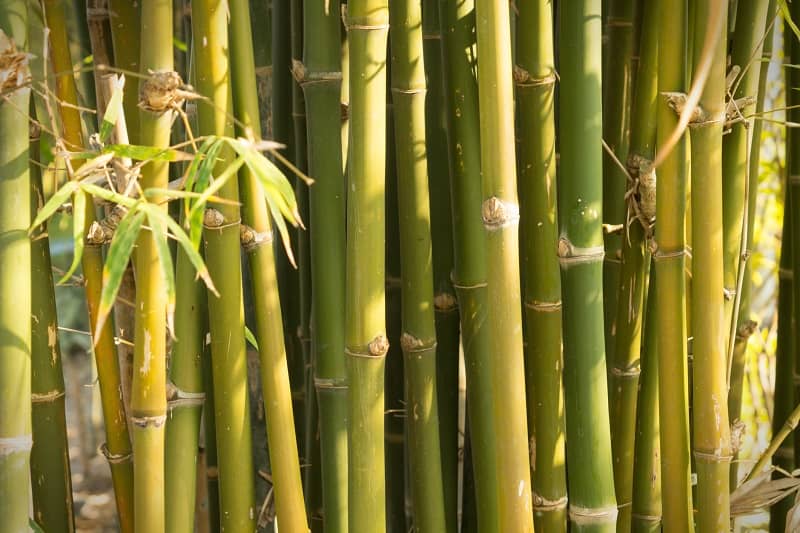
If your bamboo’s leaves are turning yellow, it can be due to something as benign as the leaves naturally yellowing as part of the plant’s life cycle. But there are other reasons for the change in color that may be cause for concern and will need to be addressed and remedied as soon as possible to avoid any lasting damage to your plant.
Yellowing of bamboo leaves can be due to a lack of nutrients, overwatering, underwatering, or stressful growing situations.
In this article, we will discuss the other signs to look out for when bamboo leaves turn yellow, what they mean, and how to remedy them.
Is bamboo leaf yellowing normal?
Bamboo is an evergreen plant, but it is normal for it to get some yellow leaves and culm. You just need to be able to discern what is normal from what is abnormal.
Bamboo sheds its old leaves in order to grow new ones, just like any other plant. These old leaves will die and fall off because the plant will cut off their access to nutrients in favor of other parts of the plant, like the new leaves. Bamboo also loses its leaves gradually and will replace them with new ones, so it is normal to see a mix of green and yellow leaves on bamboo most of the time. Springtime is when you naturally see the most yellow leaves on bamboo, because this is when it replaces the most leaves at one time.
If the leaves turn yellow and fall off, but do not get replaced with green ones, this is indicative of a possible problem.
Is bamboo culm yellowing normal?
It is possible that the bamboo you have is a yellow variety. These kinds of bamboo start out green and turn yellow as they mature. Even if your bamboo is not a yellow variety, its yellowing can still be normal. Do not worry about younger culms turning yellow; if they distract you too much you can always just trim them.
Which bamboo species have more yellow leaves and culm?
The bamboo species which produce more yellow leaves and culm are the Phyllostachys aurea, or the golden bamboo, and the Phyllostachys edulis, or Moso bamboo. These plants will lose most of their leaves in the spring.
One of the most common bamboos in the United States, the golden bamboo grows straight and strong. The Phyllostachys edulis, or Moso bamboo, is not as common in the United States, and is usually used to make bamboo threads.
How do I know if the yellowing of leaves on my bamboo is not normal?
When fresh bamboo leaves are turning yellow
If you are able to identify which of the bamboo’s leaves are new, and if those are the leaves that are turning yellow, this is indicative of a bamboo plant with an iron deficiency. This usually happens in places where the soil is alkaline. Most plants are fine with any soil pH, but if they could choose, they would prefer acidic soil. You can buy a pH testing kit for your soil so you can check it whenever you need to.
If the soil is alkaline, you can use compost containing pine needles, oak leaves and coffee grounds. Mix this with your soil and it should do the job.
You could also add an acidic plant food that contains iron. Just make sure you do not overdo it with the fertilizer.
You can also just add sulfur to the soil to make it more acidic. Add some into your soil every time you think it is becoming alkaline.
When older bamboo leaves are turning yellow
If you are able to tell which leaves are the older ones, and if they are turning yellow and not dropping off, you may need to apply fertilizer that contains nitrogen. The soil has probably run out of nutrients for the bamboo. It is best to give fertilizer when the leaves start to turn yellow.
When the bamboo leaves turn yellow with brown tips
If the leaves on your bamboo plant are turning yellow but with brown tips, this could mean that it is being underwatered and that you may need to water them more frequently.
Bamboo plants love water and if you cannot water them manually as much as they need you to, you should consider setting up a drip irrigation system. It will also help if you leave some of the fallen leaves on the soil, because they can help keep the soil moist.
When the bamboo leaves have pale yellow spots
If your bamboo’s leaves have yellow spots, you may have a pest problem. This is most likely a mite infestation. These insects are very small and difficult to spot with the naked eye, but if there are enough of them, they can deplete the nutrients from a bamboo’s leaves. You can try to get rid of these insects by using a pressure washer and insecticides. Neem oil is also effective against the mites.
When both the leaves and culm are yellow
If you have a watering schedule that you follow but the soil always seems to be soggy, there might be something wrong with the soil. Bamboos like their soil well drained and aerated.
You can try to add compost to the soil to make it drain better, and this will also provide more nutrients for the plant.
Conclusion
Bamboo leaves turning yellow can be something as benign as the normal cycle of the foliage, or it can be due to a more pressing concern that will need to be remedied.
The common causes of yellowing bamboo are iron deficiency, soil pH, lack of nutrients, watering issues, pests, and soil problems.
If you are able to identify the problem in its early stages and remedy it quickly, the bamboo will bounce back to its original vigor in no time.
Image: istockphoto.com / Peerayot